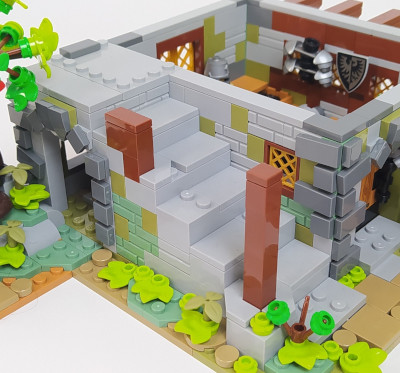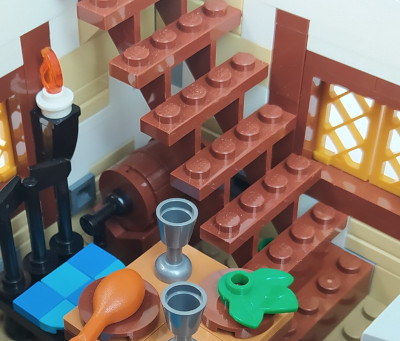Set Review ➟ 21325 Medieval Blacksmith
We have in front of us a new LEGO Ideas set. The first impression I get from looking at the box is, “wow, quite different from the original design made by AFOL Clemens Fiedler”…comparisons are odious, I know.
In the medieval line, this would be the third Blacksmith shop that LEGO puts on sale, or 4th if we count the 6918 Blacksmith Attack set, in 2011. The first time we had a blacksmith was in 1984, with set reference 6040. The set consists of 2 minifigures, a blacksmith and a crusader and with just over 83 pieces we built a small blacksmith that provided hours of play.
.jpg)
The second edition of the Blacksmith shop came out in 2002, set 3739, also based on a MOC designed by an AFOL, Daniel Siskin. This time the smithy is larger, with two levels, the ground floor for the smithy and the upper floor for the blacksmith’s house and with many more details. There are also two minifigures, the blacksmith and a maid.
.jpg)
Now it’s the turn of 21325 Medieval Blacksmith, a set that consists of more than 2000 pieces. This time we have a 3-levels building, a blacksmith shop on the ground floor, a dining room and kitchen on the first floor and a bedroom with a small desk on the upper floor.
.jpg)
GROUND FLOOR
We begin the assembly by preparing the base where the set will be settled, recreating the vegetation environment, including a small orchard where we find some pumpkins and a small bone of the blacksmith’s pet, a husky (it must be a blacksmith shop from "Siberian medieval times"). Different shades of green predominate, as well as different types of plants and leaves.
.jpg)
The facade of the building is entirely made of stone, emphasizing this detail the DBG tiles of different sizes used in certain areas such as corners or arches, which gives the whole set a realistic detail. Only in the garden area is the brown color used to simulate the wooden beams that support the projecting part of the upper floor.
.jpg)
Right next to the entrance of the smithy we find the coal forge. To simulate the fire inside the forge, orange and black Round 1x1 Tiles are used, as well as transclear plates, achieving the effect of embers very well. In addition, a red light brick is added that is operated with a pretty achieved bellows. Just in front of the forge we have a small anvil and a barrel to store the forged swords.
.jpg)
.jpg)
Stone stairs that take us to the first floor. Under these stairs we find the wood warehouse, whose entrance is a stone arch next to a tree. The tree itself is a bent apple tree, the construction of which has been the most repetitive and somewhat boring element to build. Both pieces, the ones used for the trunk, and the “Elephant Tail / Trunk” ones for the branches, make it look a bit weird, not very real.
.jpg)
.jpg)
As a detail, in the tree we find The European tree frog (Hyla arborea) and a small target for the archer to practice shooting. Just under the apple tree we find another typical element in any medieval diorama, a small well.
.jpg)
.jpg)
Let’s go inside the smithy. Access is through a door in which 1x4 tiles are used with a wooden and 4 nails screen-printed pattern. This Medium Nougat color piece appears for the first time with this set. The design of the door is quite successful, I take note as an idea to use in future medieval constructions.
.jpg)
Right in the middle of the workshop we find another anvil, with an orange ingot that simulates a piece of metal just taken from the embers ready to be shaped.
.jpg)
By the forge we find a small mountain of black round tiles, or what is the same, the coal that is used to keep the fire of the forge on. On the wall are hanging armors and a shield with the Black Falcons logo. We also have a small grinding wheel that rotates, with which to sharpen all the weapons that the blacksmith forges. In the background we have a table where there are a frying pan, a cauldron and a knight's helmet and right next to it a box containing ingots.
.jpg)
.jpg)
FIRST FLOOR
The facade of this building is the classic medieval adobe and stone facade with the typical wooden framework.

Access to this first floor is through the stone stairs built previously. The entrance door, which is the same as that of the smithy, is under a wooden porch and with a lantern of light.

.jpg)
We will build the continuation of the external chimney and a small roof over the forge, for protection, under which the sign that indicates that we are in front of a smithy will go. It is appreciated that no sticker has been used and it is a silk-screened tile. In fact, there is no sticker on the whole set.
.jpg)
Let’s move inside. In the central part we find a table full of food such as a turkey leg and vegetables, along with two glasses.
.jpg)
The table is surrounded by two chairs, upholstered in different shades of blue. The size of the chairs is 3x3, giving the impression that they are a bit out of scale. The original of these is the use of axes to make the backup.
.jpg)
We also find a small kitchen, in front of the fireplace with its wood fire and utensils such as a saucepan and a pot. To its right there is a small wooden table to prepare the food to be cooked.
.jpg)
To access the next floor, we have a wooden stairs, under which we find a small barrel that surely has the drink to fill the glasses on the table.

The lighting in the room is done with two chandeliers placed on the sides of one of the three windows that this room has. Some more chandelier or candle would have been better to improve this lighting :).
Overall, although it may seem like a small space, a balance has been achieved with the decoration and details and that there is space left without being too crowded.
UPPER FLOOR AND ROOF
I can say that this is the part that I like the most of the whole set. This part represents what would be the bedroom and the touch is that it is attic. In the center of the room there is a large wooden pillar that will support two large arched wooden beams. This is the central structure on which the roof will be anchored.
.jpg)
Going upstairs from the lower floor, the first thing you find is a low stool next to a small desk, on which there is a small silk-screened parchment on a tile next to a medieval pen and a small table with a candle. In front of the desk, a small hole and a small dormer window on the outside.
.jpg)
On the floor we find a curious detail, an animal skin, a black bear as a carpet. The bed features a bedspread in shades of green and blue and two white pillows. The end part of the bed has beautiful ornamental details.
.jpg)
Next to the bed we find a large chest, in which we find a compass rose printed on a 1x1 round tile as well as a backpack. This blacksmith must have a traveling spirit…This may give a clue to what he has started to write on the desk.
.jpg)
As it could not be missing in a room of these characteristics, we found a fireplace with the flames right next to the desk.
On the outside, what predominates is the roof. A roof made mainly with Tile Modified 2x3 Pentagonal pieces, in blue and sand green colors. This is removable to access the interior of the bedroom. The roof is made up of two structures that rest on the central part. A part will be complete. The other will have the holes in which the end of the building's chimney and another attic window appear.
.jpg)
.jpg)
.jpg)
MINIFIGURES
The set includes 4 new minifigures: 2 Black Falcon knights, one of them a female figure, an archer, who could also be the blacksmith's wife and of course, the blacksmith. In addition, they are accompanied by two animal figures, a dog and a horse.
The blacksmith comes with a red beard and a silk-screened apron on his torso. The archer’s torso is the same as the Robin Loot figure from the Pirates of Barracuda Bay set, but what makes it original is that in one of its two faces head, it brings with an eye closed, a gesture that it performs at the time to aim the bow.
.jpg)
The Black Falcons are back! and with a female minifig. The torsos have been updated, with a slight modification of the coat of arms. The knights come fully equipped with armors, helmets, swords, and a halberd. In addition, we can build a 4-wheeled cart, drawn by the horse, in which the knights can transport their entire arsenal.
.jpg)
.jpg)
The dog figure is the classic husky that we find in many sets. We are more interested in the figure of the horse. It is a new figure, with the great novelty that the hind legs can be moved and in Tan color. Until now, all horses allowed us to move the front legs, but not the back ones, so it means a great innovation. I have to admit that it is a bit strange, so used to the usual horses, seeing this one made me quite strange and I had a moment of rejection, but watching the playability that it can give, it is appreciated.
.jpg)
.jpg)
CONCLUSIONS
It is obvious that the set is indispensable for most medieval-themed dioramas. The design, although it differs from the original (aesthetically it attracts me more) I must admit that they have achieved a quitte decent result. They manage to capture the essence of medieval houses, with those wooden frameworks on the façade, set on the first floor and the stone chimney.
As for the details and interior decoration, they manage to fill the rooms with enough detail (I love that bear carpet) but without saturating them and leaving space for the minifigs.
Also noteworthy that no stickers have been used throughout the set and that they have rescued the Black Falcons after so many years. Another point in favor would be the horse, with movable hind legs. As a negative note, the tree. I think it's the only element that I didn't like about the whole set.
I think that to accompany the set, the tree design could have been better, specifically the trunk and branches, also being a repetitive assembly, it is a bit convoluted, but hey, we like LEGO and we will know how to make the pertinent modifications to amend this.
.jpg)
33470